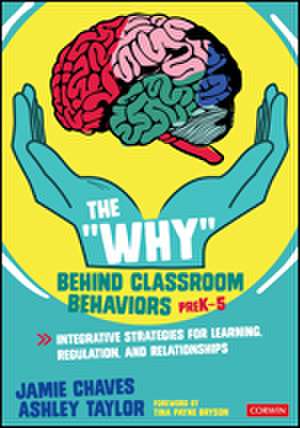The "Why" Behind Classroom Behaviors, PreK-5: Integrative Strategies for Learning, Regulation, and Relationships
Autor Jamie E. Chaves, Ashley Tayloren Limba Engleză Paperback – 3 noi 2020
- Build confidence in identifying and addressing behaviors in order to support student growth and brain development
- Learn about an interdisciplinary approach that combines education, occupational therapy, and psychology to better understand and navigate brain-based regulation, relationships, and behaviors in the classroom
- Use relevant research, illustrations, and strategies for reflective and experiential moments
- Discover strategies to facilitate co-regulation, establish positive classroom relationships, address sensory needs, communicate with parents, and practice self-care
This reflective, insightful book provides workable strategies to help all students, as well as those who care for them, feel more competent, confident, and successful.
Preț: 279.75 lei
Nou
53.55€ • 55.08$ • 44.43£
Carte disponibilă
Livrare economică 27 ianuarie-10 februarie
Livrare express 10-16 ianuarie pentru 37.88 lei
Specificații
ISBN-10: 1071816101
Pagini: 312
Dimensiuni: 178 x 254 x 20 mm
Greutate: 0.64 kg
Ediția:1
Editura: SAGE Publications
Colecția Corwin
Locul publicării:Thousand Oaks, United States
Recenzii
"This manuscript digs deeper than the usual classroom behavior books do. With it's deep dive into brain research, it helps the reader better understand the why behind so many of the behaviors that are seen in the classroom today. I was able to implement many of the strategies immediately into my own classroom. "
"With the pressure of test scores, the “why” helps us to address and help students become successful. This book will be very beneficial for teachers to use."
"Educators are always asking why students do what they do. We need to ask why. This book will provide practical, realistic and useful guidance for educators. It will allow students to develop progress academically and emotionally in a positive supportive environment. "
"Searching for the Why is highly useful, and needed for teachers. The current brain -based research, clear writing style that makes it easy to understand, good real life examples of typical misbehaviors, charts for diagnosing one’s own students, and very good advice on preparing for meetings with parents and special education staff is essential for educators in the field."
| Searching for the Why |
Cuprins
Preface
Acknowledgments
About the Authors
Chapter 1: Searching for the “Why?”
A Brief Introduction to Interpersonal Neurobiology
Applying a Brain-Based, Relational Lens to the Educational Setting
Chapter 2: Regulation as the Foundation for Learning
What Is “Regulation”?
Reframing the Developmental Expectations of Regulation
Developmental Milestones in Regulation
Promoting Regulation in the Classroom
Chapter 3: The Teacher-Student Dyad and Classroom Community
Understanding the Teacher-Student Dyad and Regulation-Response Cycle
The Power of Mirror Neurons
Harnessing the Positive Power of Mirror Neurons
Rupture and Repair
Facilitating the Continued Development of a Teacher-Student Dyad
Chapter 4: Foundations of Sensory Processing for Regulated Learning
Foundations of Sensory Processing in the Classroom
Teacher-Student Dyad and Sensory Processing
Sensory Systems and Their Impact on Learning
Facilitating Sensory Integration for More Engaged Learning
Chapter 5: Building a Sensory Smart Classroom
Sensory Preferences and Sensory Processing Disorder—What’s the Difference?
Recognizing Different School-Based Sensory Needs
Chapter 6: Developing an Awareness of Individual Differences and Promoting Integration
Recognizing Individual Differences
Moving Toward Integrated Learning
Teaching Students to Search for the Why
Language-Based Learning Disabilities
Nonverbal Learning Challenges
Giftedness and 2E
Other Common Diagnoses That Impact Learning
Common Misconceptions Regarding Learning Disabilities
The Power of Early Intervention
Supporting Integration of Students With Individual Differences
Chapter 7: Handwriting That Promotes Integrated Learning
Developmental and Sensorimotor Facets of Handwriting
Writing as an Integrated Brain Activity
Regulation and Handwriting
Facilitating Improved Handwriting
Chapter 8: Considerations for Specialty Teachers
A Note about Relationships and Regulation in Specialty Classes
Sensorimotor Factors in Specialty Classes
Learning Differences Unique to Specialty Classes
Boosting Regulation and Participation in Specialty Classes
Chapter 9: Redefining Behavior Plans
A Note About Behavior Plans
Structure, Appropriate Boundaries, and Clear Expectations
Natural Versus Punitive Consequences
The Power and Peril of Praise
The Lifespan of a Meltdown and In-The-Moment Strategies
Putting It All Together: A Newly Defined Behavior Plan
Chapter 10: Supporting Students Who Need Additional Help
Understanding Supports Within Your School
Accessing External Supports
Establishing a Teacher-Parent Dyad
Preparing for a Parent Meeting
References
Index
Notă biografică
Dr. Jamie Chaves, OTD, OTR/L, SWC, is a pediatric occupational therapist with over 8 years of experience working with children who have sensory processing differences and learning differences. She received bachelor¿s degrees in health science and Psychology from Bradley University, and a doctorate of Occupational Therapy from Washington University School of Medicine in St. Louis. Dr. Chaves is the division leader for the occupational therapy department at The Center for Connection in Pasadena, CA¿a multidisciplinary clinic that provides an array of services rooted in the IPNB framework. She recognizes the importance of a play-based, relationship-based approach to therapy that is rooted in regulation. She does contract work with various private schools in Pasadena, CA, particularly delivering teacher in-services and parent education on a variety of topics including promoting positive handwriting, sensory integration strategies in the classroom, how diet and sleep influence learning and regulation, and the impact of screen time on development and learning. Dr. Chaves lives in Pasadena, CA with her husband and 2 young children.
